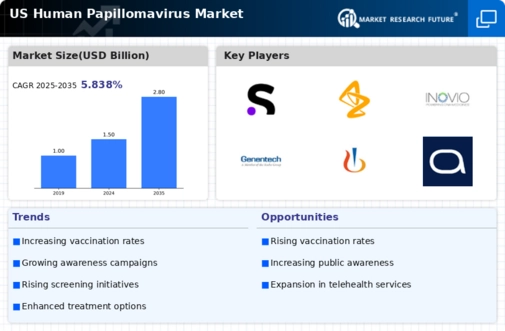Market Growth Projections
The Global US Human Papillomavirus Market Industry is projected to experience substantial growth, with estimates indicating a market value of 3.5 USD Billion in 2024 and a potential increase to 7.2 USD Billion by 2035. This growth trajectory suggests a compound annual growth rate of 6.78% from 2025 to 2035. Such projections reflect the increasing recognition of HPV's public health implications and the concerted efforts to enhance vaccination coverage and awareness. The market dynamics are influenced by various factors, including advancements in vaccine technology, government initiatives, and rising awareness of HPV-related health risks.
Advancements in HPV Vaccination
Innovations in HPV vaccination are driving the Global US Human Papillomavirus Market Industry forward. The introduction of new vaccines and improved formulations enhances efficacy and safety profiles, encouraging higher uptake among the target population. For example, the recent approval of vaccines that cover a broader range of HPV types has the potential to significantly reduce the incidence of HPV-related cancers. This advancement is likely to bolster vaccination rates, contributing to a projected market growth to 7.2 USD Billion by 2035. The ongoing research and development in this area suggest a promising future for HPV prevention strategies.
Increasing HPV Awareness Programs
The Global US Human Papillomavirus Market Industry is experiencing growth due to the rise in awareness programs aimed at educating the public about HPV and its associated health risks. Initiatives by health organizations and government bodies are crucial in disseminating information regarding HPV transmission, prevention, and the importance of vaccination. For instance, campaigns targeting adolescents and young adults have shown promising results in increasing vaccination rates. This heightened awareness is expected to contribute to the market's expansion, with projections indicating a market value of 3.5 USD Billion in 2024, reflecting a growing recognition of HPV's impact on public health.
Government Initiatives and Funding
Government initiatives and funding play a pivotal role in shaping the Global US Human Papillomavirus Market Industry. Increased allocation of resources towards HPV vaccination programs and public health campaigns reflects a commitment to reducing HPV-related diseases. For instance, federal and state governments have implemented programs that provide free or subsidized vaccinations to underserved populations. Such initiatives not only enhance accessibility but also encourage higher vaccination rates, thereby potentially increasing the market size. The anticipated growth rate of 6.78% CAGR from 2025 to 2035 underscores the importance of sustained government involvement in HPV prevention efforts.
Rising Incidence of HPV-Related Cancers
The rising incidence of HPV-related cancers is a significant driver for the Global US Human Papillomavirus Market Industry. As awareness of the link between HPV and various cancers, such as cervical and oropharyngeal cancers, increases, there is a growing demand for preventive measures, including vaccination and screening. Health statistics indicate that HPV is responsible for nearly 90% of cervical cancer cases, prompting health authorities to prioritize HPV prevention strategies. This trend is likely to fuel market growth, as more individuals seek vaccination and screening services to mitigate their cancer risk.
Emerging Markets and Global Collaboration
Emerging markets and global collaboration are influencing the Global US Human Papillomavirus Market Industry. As countries worldwide recognize the importance of HPV prevention, there is an increasing trend towards international partnerships aimed at sharing resources, knowledge, and best practices. Collaborative efforts between governments, NGOs, and healthcare organizations facilitate the implementation of effective HPV vaccination programs in various regions. This global approach not only enhances the reach of vaccination initiatives but also contributes to the overall growth of the market, as more populations gain access to HPV prevention strategies.











